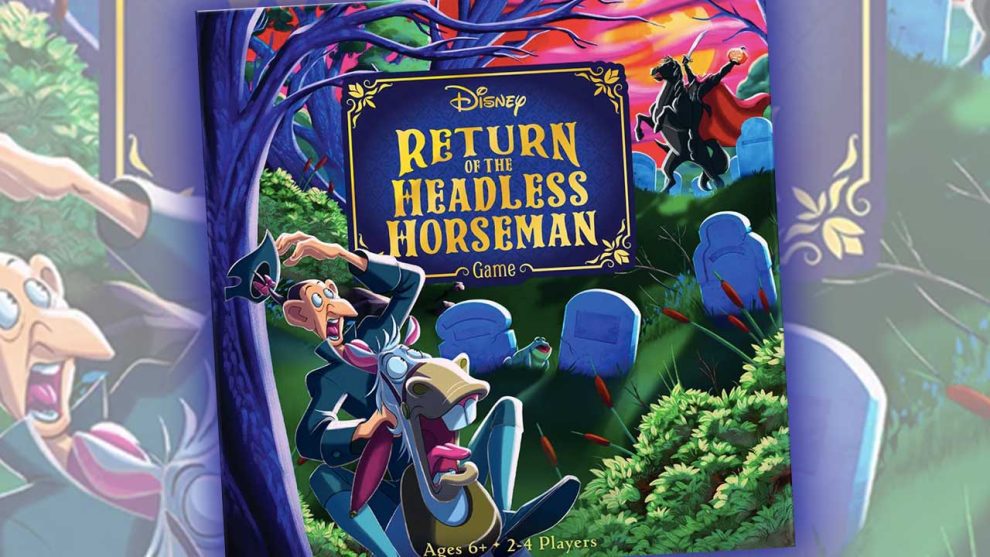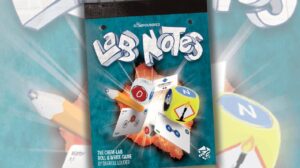Disclosure: Meeple Mountain received a free copy of this product in exchange for an honest, unbiased review. This review is not intended to be an endorsement.
Few moments in life cannot be made sweeter by the balmy crooning of Mr. Bing Crosby. True, we most often associate that iconic voice with Christmas, but we mustn’t forget his contribution to the frighteningly spirited celebration of Halloween. For it was Crosby, you recall, who narrated and sang the score of Disney’s 1949 classic The Legend of Sleepy Hollow.
The animated adaptation—like so many Disney titles—has perhaps eclipsed the original to become the more widely known telling of Washington Irving’s classic American short story. Thankfully, this particular adaptation is faithful enough to its namesake to avoid (too many) snarky comments in a board game review. Nevermind that the original tale had nothing to do with Halloween—overall, I’d say Disney nailed it.
Our friends at Funko have adapted the Disney adaptation to create Return of the Headless Horseman, a cooperative game in which Ichabod Crane attempts to outrun the headless phantom to the old covered bridge. “For once you cross that bridge, my friend, the ghost is through, his power ends.” At least that’s how Bing Crosby sang it.
Just gather ‘round and I’ll elucidate
Sleepy Hollow is the setting of a board that will undoubtedly remind you of Candyland with a hint of Chutes and Ladders (without the chutes). There is a hole in the board through which the Hollow’s spooky tree is fastened as an upright spinner. Miniatures for Ichabod and the Horseman are placed on their starting spaces. Eight Scare tiles are set beside the board, face down, and each player receives four cards from the nearby deck.

Turns are universal. Each player lays one card from their hand in an attempt to move Ichabod along the path. Cards feature numbers between one and six. If two of the played cards feature a match, Ichabod moves that number of spaces. If not, players must lay a second card to create the match, and so on.
Therein lies the trouble, though, for each card may also contain a movement number for the Headless Horseman. Once Ichabod has moved, each and every Horseman number is added together to race the phantom in pursuit.
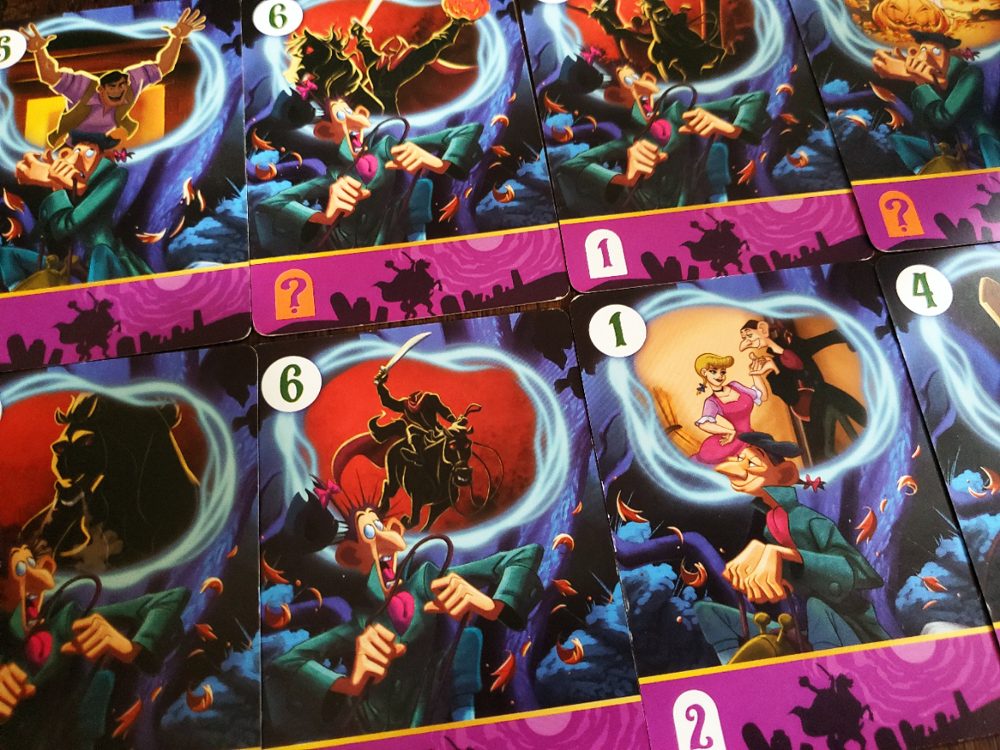
There are three types of special spaces scattered about the board. Signposts lay out secret passages (ladders) to give Ichabod a boost. Spooky Trees allow players to spin the tree for bonus movement, but that movement is not always a blessing because of the Scare spaces which force players to flip one of the Scare tiles.
Four of the Scare tiles form the image of the Horseman’s flaming pumpkin. If all four are revealed, the game is lost. Tiles are flipped either when landing on the aforementioned spaces or if the Horseman catches Ichabod. In the latter case, Ichabod is “scared” forward to the next unmarked space before a tile is flipped.
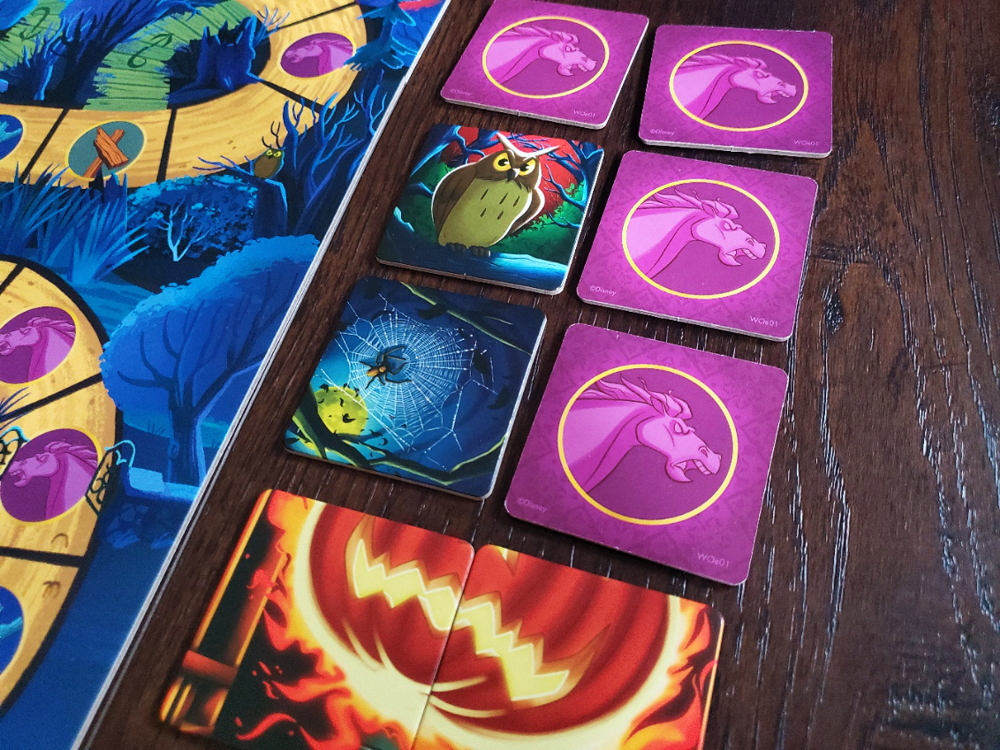
One final quirk is unleashed when Ichabod arrives at the spooky tree. Ichabod himself is placed on the tree and spun out of his wits in order to determine the space from whence his flight will continue. The final flight to the finish then commences. If Ichabod reaches the covered bridge without being scared to death, he escapes and the crew wins!
Along the way, when a player has only one card left in hand, they shout “Ichabod!” and spin the tree to determine how many cards to draw from the deck. This little mechanism adds a touch of variety to the number of available cards around the table, not to mention a little joyful noise.
You can’t reason with a headless man
Nevermind the fact that Ichabod Crane is only questionably worth saving either in the original tale or the Disney adaptation. This game is all about the thrill of the hunt, and it is a near-perfect game for kids. I love that it looks like a midnight version of two kids’ games I’d rather toss in the brook of Sleepy Hollow because it highlights just how wonderful a title the folks from Prospero Hall have created.
I’ll start with the board. Opening the box, you are met with a serene image of Sleepy Hollow and a word of foreboding. It is a lovely welcome and a hint of the care given to recreating the feeling of the cartoon. Only a triggered audio greeting from Bing Crosby himself could make the first meeting more fit. The back of the rulebook likewise features the bridge—the morning after Ichabod Crane disappears—along with text from the animation pulled directly from Washington Irving. Magnificent.
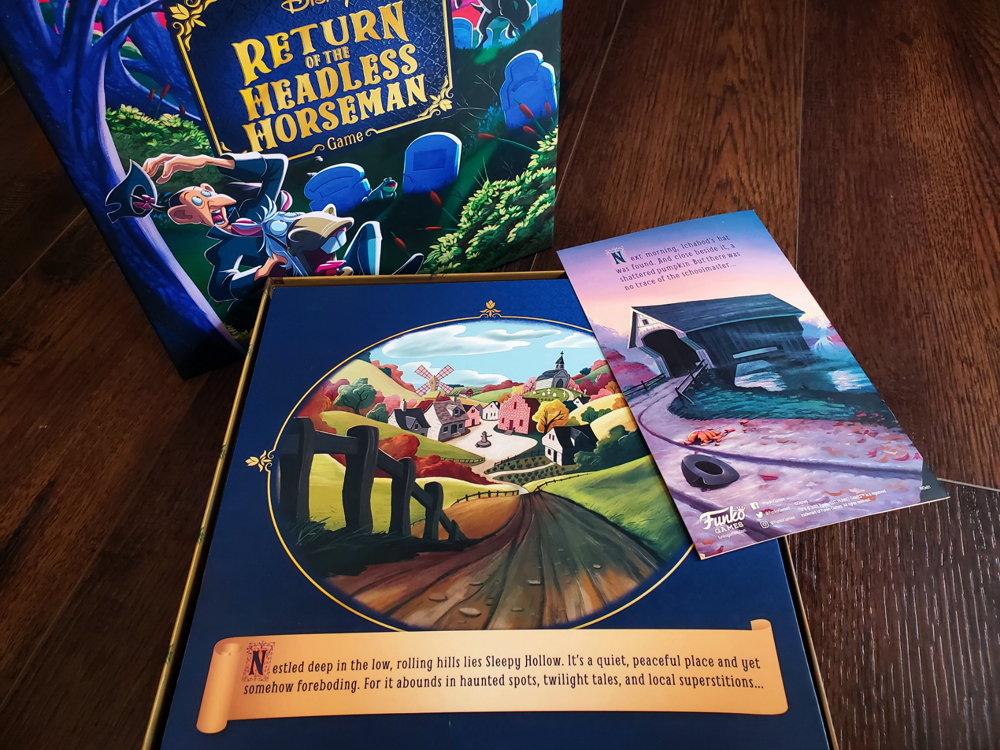
And the spinning tree! Oh, that tree! Having just reviewed Funko’s Big Thunder Mountain Railroad and begged for just such a setup, I have to ask, where was the communication between the Hollow and the Mountain? This tree is by no means perfect, but it spins so easily and adds a wonderful 3D touch to the setup. The creative team could have learned from… themselves on that one.
The card play is quite clever. It sounds simple enough, just match a card! But there is depth in looking over the board and deciding where you feel Ichabod should land next, and then wrestling the cards you may or may not have to make such a thing happen. Sometimes you are forced to look over a hand of terrible cards and play the one least likely to match, just to keep the schoolmaster safe. But what if someone else was in the same situation and thought the same thoughts? What if there are no matches and you’re then forced to try to avoid a match with four cards already in play? This is no land of candy. This is a hollow of vocal tension.
And let’s talk about getting vocal. Kids love shouting, so it should come as no surprise that kids are eager to get down to one card so they can shout “Ichabod!” and spin that tree. The one rule that simply must be honored, though, is keeping quiet about the cards to play. The game says select in secrecy, but we go one step further to forbid discussion of strategy. No quarterbacking. No instructing the four-year-old to play a three because that will set Ichabod on the shortcut. Instead, you wait and see how she plays a five because she likes the way Katrina looks on the card and then you get vocal. And my goodness, does this game get vocal, from running away to being caught, from flipping pumpkin bits to getting Ichabod dizzy when he gets caught on the tree.
There is even a hint of variety in the game. Some of the Horseman cards have a wild marking that can be assigned a value at the start of the game. A value of two means the Horseman moves less. A value of four means he will be sniffing at Ichabod’s ponytail the whole time. The design team even included a suggestion of having one player with no hand, only a blind play from the top of the deck each turn. There are ways to make this outing even more exciting.

And the very best part? Fifteen minutes. The box says fifteen minutes and the box means fifteen minutes. You run and you shout and you may or may not survive, but it’ll all happen in fifteen minutes.
Grabbing at intellectual properties often results in shallow one-off experiences aimed more at the rush of nostalgia than any lasting engagement. I’m not saying Return of the Headless Horseman has avoided that horse completely, but there is a solid family game here—all the appeal of those Milton Bradley classics with a tinkling of strategy and excitement that is not entirely random. Yes, you will randomly receive a number of cards, but you will make a reasoned choice with those cards (unless you happen to be four years old). Yes, you will randomly pop off the tree back to the path, but you will continue to agonize over how to move or not move Ichabod, and how to move or not move the Horseman. And yes, you will randomly flip tiles hoping to avoid the worst Scares, but isn’t that what it’s all about when you’re running for your life through a haunted hollow? Survival doesn’t really come into question, after all, until that fourth draw.
If you know The Legend of Sleepy Hollow from any source, dust off your copy and read it again, or dust off your VHS copy and watch it again. It’s a worthy story. You might just find yourself impersonating Bing Crosby for the rest of the day. But even if you enter the Hollow unawares, there is much to enjoy on this wooded path.


